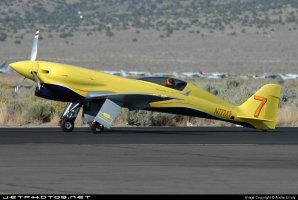aleatorylamp
Charter Member
Hello Folks, (long time no see...) There is something new I was trying out, that possibly, perhaps, might be of interest for CFS1 enthusiasts: Emmulating Electro Aicraft Power in the .air file. Electric GA aircraft are most probably more interesting for FS98, but maybe CFS1 fans would fancy an electrically powered attack drone, like the RQ-20 Puma. I found a rather peculiar way to implement electro-power in CFS1 and FS98, by using a jet .air file (Eeeek! A jet!!), but with Records #401 and #404 (CLI vs AoA and CLI vs Mach) from the Cessna 182, as these wings and speeds are more fitting. Also to bear in mind for experimental purposes, would be the wings from the AF99 Balsa Glider Tutorial or from the AF99 sample Ultralight Aircraft. The most notable feature in the flight dynamics of an electric CFS1 aircraft would be that fuel is a battery stack, with no weight difference between full and empty charges. It would be included in the dry weight. In CFS1, we can achieve a very close approximation by defining a 1 USG fuel tank, keeping the difference to a minimal 6.6 lb. Depending on engine power and Battery Charge capacity( in Kilowatt-Hours), we adjust the Fuel Consumption Parameter to get specified endurance and/or range, much reducing the usual 400-440 value for jets. We can check electric current drain - i.e. pph fuel consumption - using the Lear45 EICAS gauge, as an approximate guide. With our 1-USG tank, a value of 12 pph will get us about half an hour´s endurance. Incidentally, testing for range can be made easier by increasing FS98 simulation rate. Then, to complete the emmulation, we can make a funtional instrument panel using stock FS98 gauges with modified bitmaps are for N1 and N2 Bell Helicopter engine gauges, which will be made to display Kilowatt Power and engine RPM respectively. To monitor battery charge, we use the Extra300 Acro Tank fuel gauge, which conveniently displays fuel in the tank as a percentage. It is a left tank, which we position at 0,0,0, and with a modified gauge bitmap, it shows % battery charge. The most important step is to begin by defining engine thrust. We have to convert specified horsepower to foot-pound thrust, also taking into account the higher torque of an electric motor, most noticeable in the specified rate of climb. Depending on engine size, I found the following Hp to Flb Thrust conversion factors to work very well, producing the necessary torque to maintain the rate of climb specified by the manufacturers of a couple of aircraft. Of course MTOW will also play an important role. - Medium sized engines of 400 KW - 535 hp (Rolls Royce Spirit of Innovation): Conversion factor of 3 x Hp. - Medium-small engines of 260 KW - 300 hp (Siemens-Extra 300LE): Conversion factor of 2.43 x Hp. - Small engines of 60 KW - 80 Hp (Pipistrel Alpha Electro): Conversion factor of 5 x Hp. So, with reference to military armed attack drones such as the RQ-20 Puma, I was wondering if there could be any interest for such a thing here in this forum. Cheers, Aleatorylamp. P.S. I was trying to divide this post into paragraphs, but I haven´t been successful.




